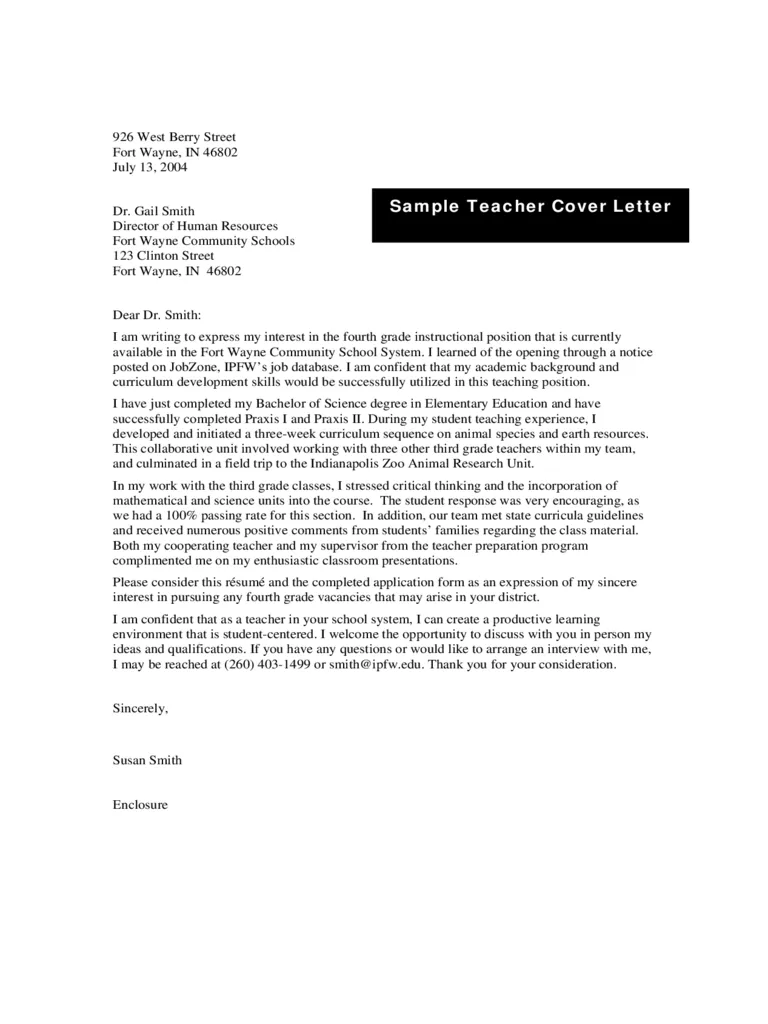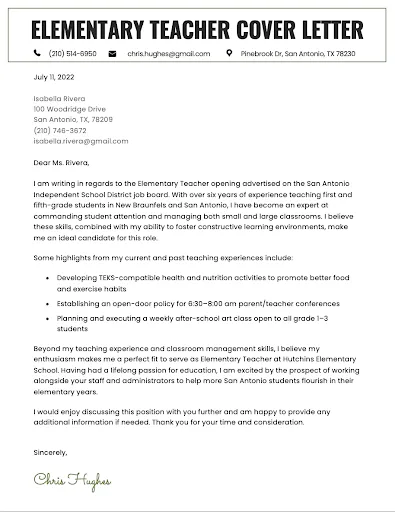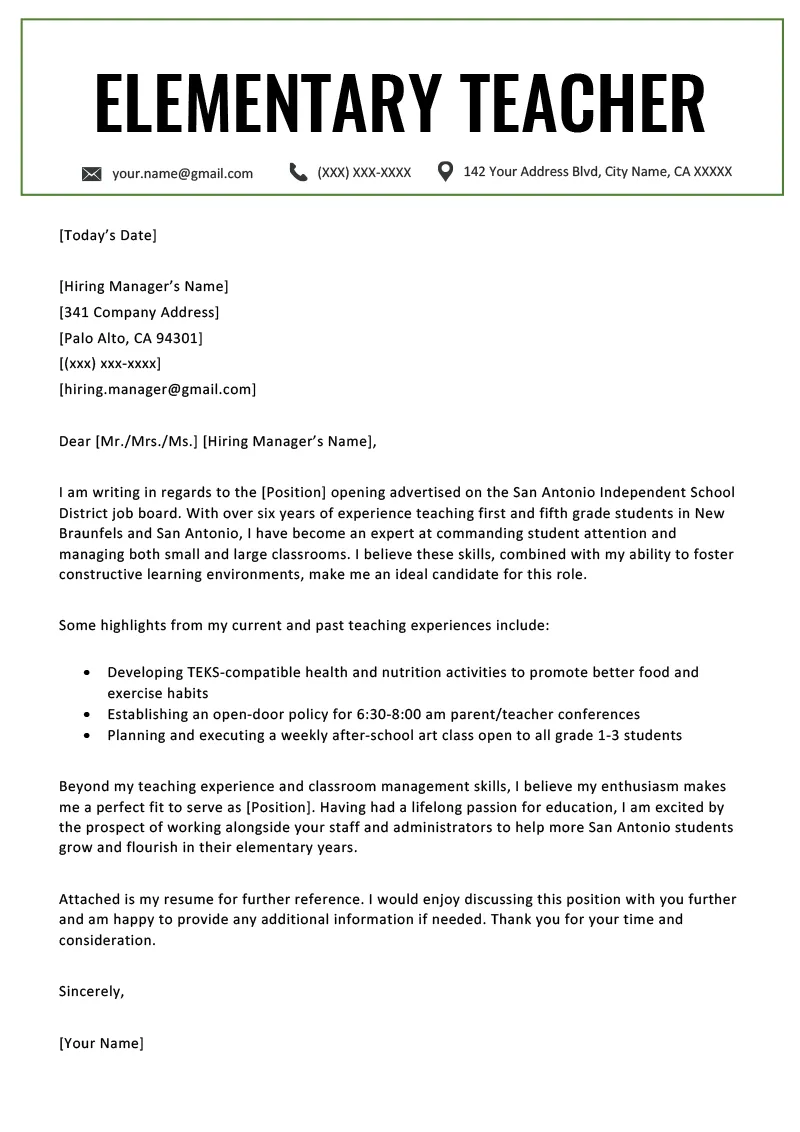Crafting the Perfect Teacher Cover Letter
A well-crafted teacher cover letter is your first opportunity to make a strong impression on a potential employer. It goes beyond simply listing your qualifications; it’s a chance to showcase your personality, your passion for teaching, and your unique skills. This guide provides a comprehensive overview of how to write a compelling cover letter that will significantly increase your chances of landing an interview and ultimately, your dream teaching position. We’ll explore every element, from understanding its purpose to formatting and design, and provide actionable tips and examples to help you succeed. A great cover letter will set you apart from other candidates, demonstrating why you are the best fit for the role.
Understanding the Purpose of a Teacher Cover Letter
The primary purpose of a teacher cover letter is to introduce yourself and highlight the key aspects of your resume in a more personalized and engaging manner. It is not merely a repetition of your resume; rather, it serves to provide context, demonstrate your enthusiasm, and explain why you are particularly suited for the specific teaching position. The letter should reflect your teaching philosophy, your understanding of the school’s needs, and your ability to create a positive and effective learning environment. Think of it as your chance to make a personal connection with the hiring manager before they even meet you. The cover letter complements your resume, adding depth and personality to your application.
Highlighting Your Qualifications

Your cover letter is the perfect space to highlight your relevant qualifications and experiences in a way that directly addresses the requirements of the teaching position. Carefully review the job description and identify the key skills, experiences, and qualities that the school is seeking. Then, weave these elements into your letter, providing specific examples of how you have demonstrated these attributes in your past roles. This could include your experience with lesson planning, classroom management, student assessment, or any specialized teaching methodologies. By tailoring your letter to the specific needs of the school, you demonstrate that you have taken the time to understand their requirements and are confident in your ability to meet them.
Key Elements to Include in Your Cover Letter
Your Contact Information and Date
Start your cover letter with your full name, address, phone number, and email address. This information should be clearly displayed at the top of the letter, allowing the hiring manager to easily contact you. Include the date, formatted correctly, below your contact information. This shows professionalism and helps with record-keeping. Ensure that the contact information is up-to-date and professional; use a professional-sounding email address, not one that is informal or outdated.
Addressing the Hiring Manager Correctly

Always address the hiring manager by name if possible. This shows that you have taken the initiative to research the school and the specific person responsible for hiring. If you are unable to find the hiring manager’s name, use a professional salutation like ‘Dear Hiring Committee’ or ‘Dear [Department Name] Hiring Team.’ Avoid using generic salutations like ‘To Whom It May Concern,’ as this can make your letter seem impersonal. You can often find the hiring manager’s name on the school’s website, the job posting, or by contacting the school directly.
The Opening Paragraph Grab Attention
The opening paragraph is your opportunity to grab the reader’s attention and make a strong first impression. Briefly state the position you are applying for and where you saw the job posting. Then, quickly highlight one or two of your most impressive qualifications or experiences that align with the school’s needs. Consider using a compelling statement that expresses your enthusiasm for the position or your passion for teaching. Keep the opening concise, engaging, and tailored to the specific school and position. A strong opening sets the tone for the rest of your letter and encourages the hiring manager to continue reading.
Showcasing Your Teaching Experience
The body of your cover letter should provide detailed examples of your teaching experience. Describe your previous teaching roles, including the grade levels, subjects taught, and the specific responsibilities you held. Focus on the impact you made in each role, such as improved student performance, innovative teaching methods implemented, or successful classroom management strategies. Use action verbs to describe your accomplishments and quantify your achievements whenever possible. Provide specific examples that demonstrate your skills and how you have effectively applied them in a classroom setting. This is where you provide evidence of your capabilities.
Quantifying Your Accomplishments

Wherever possible, quantify your accomplishments to demonstrate the impact of your work. Instead of saying, “Improved student engagement,” say, “Increased student engagement by 20% through the implementation of project-based learning.” Instead of stating that you “Improved test scores,” say, “Improved student test scores by 15% in mathematics.” Numbers provide concrete evidence of your success and make your achievements more compelling. Use data to showcase your skills and the positive outcomes you have achieved in previous teaching roles.
Emphasizing Your Skills and Abilities
In addition to your experience, highlight your key skills and abilities that are relevant to the teaching position. These can include classroom management, lesson planning, curriculum development, student assessment, communication, collaboration, and technology integration. Provide examples of how you have effectively utilized these skills in your teaching practice. Demonstrate your ability to create a positive learning environment, differentiate instruction, and meet the diverse needs of students. Tailor these skills to match the requirements outlined in the job description.
Highlighting Relevant Skills
When highlighting your skills, focus on those that are most relevant to the specific teaching position you are applying for. Review the job description carefully and identify the key skills and qualifications that the school is seeking. Then, provide specific examples of how you have demonstrated those skills in your previous roles. This could include examples of how you have effectively managed a classroom, differentiated instruction to meet the needs of diverse learners, used technology in the classroom, or collaborated with parents and colleagues. This targeted approach demonstrates that you are a good fit for the specific role.
Demonstrating Your Passion for Teaching

Express your genuine passion for teaching throughout your cover letter. This could include mentioning your teaching philosophy, your commitment to student success, or your enthusiasm for the subject matter. Share what motivates you to be a teacher and what you find most rewarding about the profession. Let your personality shine through and demonstrate your genuine interest in the school and the teaching position. This will make your letter more memorable and will resonate with the hiring manager, who is looking for a passionate and dedicated educator.
Writing a Strong Closing Paragraph
The closing paragraph should reiterate your interest in the position and express your enthusiasm for the opportunity. Reiterate your key qualifications and how they align with the school’s needs. Summarize your interest in the position, restating your enthusiasm to contribute to the school’s mission. Thank the hiring manager for their time and consideration. Then, clearly state your availability for an interview and provide your contact information again, if desired. A strong closing leaves the hiring manager with a positive impression and encourages them to contact you.
Expressing Your Gratitude and Next Steps
Always express your gratitude for the hiring manager’s time and consideration. Thank them for reviewing your application and for the opportunity to be considered for the position. Indicate your availability for an interview and reiterate your contact information. State that you look forward to hearing from them soon. This final touch leaves a positive impression and demonstrates your professionalism and enthusiasm for the position.
Cover Letter Formatting and Design

The formatting and design of your cover letter are just as important as its content. A well-formatted cover letter is easy to read and presents a professional image. Pay attention to the font, spacing, and overall layout to ensure your letter is visually appealing and easy to navigate. Proper formatting shows your attention to detail and professionalism, which is highly valued in the teaching profession.
Choosing the Right Font and Font Size
Choose a professional and easy-to-read font, such as Times New Roman, Arial, or Calibri. Avoid using overly decorative or unconventional fonts, as they can be difficult to read. Use a font size of 11 or 12 points for the body of your letter, as this is the standard size for professional documents. Ensure that the font size is consistent throughout the letter. Make sure the font is readable both on paper and on a computer screen.
Using Proper Grammar and Spelling
Proofread your cover letter carefully for any grammatical errors or spelling mistakes. These errors can detract from your professionalism and make a negative impression on the hiring manager. Use spell-check and grammar-check tools to identify potential errors, but also proofread the letter yourself, as these tools may not catch all errors. Have a friend or colleague review your letter as well, as they may catch errors that you have missed. Attention to detail in grammar and spelling reflects your commitment to excellence.
Keeping Your Cover Letter Concise
Keep your cover letter concise and to the point. Aim for a one-page letter, as hiring managers often have limited time to review applications. Focus on the most relevant and impactful information, and avoid including unnecessary details. Use clear and concise language, and avoid jargon or overly complex sentences. Make every word count and ensure that your message is clear, compelling, and easy to understand. Brevity demonstrates respect for the hiring manager’s time and highlights your most important qualifications effectively.
Cover Letter Examples for Inspiration
Reviewing cover letter examples can provide valuable inspiration and guidance. Many online resources offer templates and examples for various teaching positions. Look for examples that are tailored to your specific teaching area, grade level, and experience. Analyze the structure, language, and tone of successful cover letters to understand how they effectively communicate the applicant’s qualifications and passion for teaching. Tailor any template to your own unique skills and experience, and always ensure your cover letter reflects your voice and personality. Adapt examples to fit your specific circumstances.
Elementary Teacher Cover Letter Example
In an elementary teacher cover letter, focus on your experience working with young children, your knowledge of child development, and your ability to create a nurturing and engaging learning environment. Highlight your experience with early literacy, numeracy, and social-emotional learning. Share examples of how you have differentiated instruction to meet the diverse needs of students. Mention any experience with parent communication, classroom management, and fostering a positive classroom community. Tailor your examples to align with the elementary school’s specific mission and values.
Secondary Teacher Cover Letter Example
A secondary teacher cover letter should emphasize your subject matter expertise, your ability to engage adolescents, and your experience with lesson planning and curriculum development. Highlight any specialized training or certifications, such as those in STEM, AP courses, or special education. Showcase your classroom management skills and ability to create a positive and supportive learning environment for older students. Emphasize your ability to inspire students, foster critical thinking, and prepare them for college or careers. Always tailor your letter to the specific subject and school.
Tips for Tailoring Your Cover Letter
Customizing your cover letter for each job application is crucial for demonstrating your genuine interest in the specific position and school. Take the time to research the school, understand its mission and values, and tailor your cover letter to align with its specific needs. This shows that you are not simply sending out a generic application, but that you are genuinely interested in the school. The more tailored your cover letter is, the better your chances of standing out and getting an interview.
Researching the School and Its Values
Before you start writing, research the school’s mission, values, and programs. Visit the school’s website, read its mission statement, and learn about its educational philosophy. Understand the specific needs of the school and identify how your skills and experience align with those needs. Mention specific programs, initiatives, or values that resonate with you, and explain why you are particularly drawn to the school. This research shows your genuine interest and your understanding of the school’s unique character.
Matching Your Skills to the Job Description
Carefully review the job description and identify the key skills, qualifications, and experiences that the school is seeking. Use the job description as a guide to tailor your cover letter to the specific requirements of the position. Highlight the skills and experiences that match the requirements outlined in the job description. Provide specific examples of how you have demonstrated these skills and experiences in your previous roles. Use keywords and phrases from the job description to ensure that your application is easily scanned by applicant tracking systems. This targeted approach ensures that you address the specific needs of the school.
Proofreading and Editing Your Cover Letter
Always proofread and edit your cover letter carefully before submitting it. Errors in grammar, spelling, or punctuation can detract from your professionalism and make a negative impression on the hiring manager. Use spell-check and grammar-check tools to identify potential errors, but also read the letter yourself, as these tools may not catch all errors. Have a friend or colleague review your letter as well, as they may catch errors that you have missed. Proofreading and editing demonstrate your attention to detail, commitment to quality, and professionalism, all essential qualities for a teacher.
